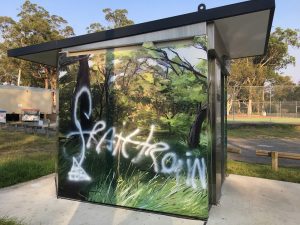 [dropcap]G[/dropcap]raffiti. Some people just hate it. Others defend it as a genuine form of art.
[dropcap]G[/dropcap]raffiti. Some people just hate it. Others defend it as a genuine form of art.
But as is always the case, beware of extreme points of view.
And indeed the rest of us are wary of both the haters and the defenders.
From where I sit it looks like the great bulk of people don’t think graffiti is art, but nor are they inclined to defend it.
No, most people just think illegal graffiti does not improve the look of noise walls along railway lines or public buildings in shopping areas or paling fences.
Indeed some people think graffiti is a symbol of the decline of western civilisation, because its practitioners thumb their noses at the laws of society.
It would be interesting to run a vox pop on the graffiti on the side of this public toilet in a bushland suburb of Campbelltown, which is pictured here.
If we accept that graffiti is art, then the question is, what was the point of defacing art by putting more art over the top of it?
It’s obvious that Campbelltown Council thought that it could keep graffiti at bay by erecting dunnies with such arty walls on the outside.
But it has now confirmed the widely held belief that graffitists don’t need a blank wall to do their stuff.
Attempts have been made in the past to bring graffiti into the mainstream by making certain public places available for such “art’’.
I don’t profess to be an expert, but it would be reasonable to assume from the lack of success that there is an element of defying society in graffiti.
It’s obviously not just about the illicit scribbling or drawing something on a public wall or object.
And let’s be honest, some graffiti is quite attractive, but that’s because it was commissioned by a public authority.
Either way, I am not sure there is any need to lose any sleep over graffiti.

There’s a difference between graffiti as art, and tagging. Scribbling your name on stuff is something most kids learn to stop doing by the age of 4.
I agree with that.
I agree with Lorraine. This is just a tag…if these idiots want to do this, they can tag their own shit and leave public and other people’s property alone. It’s called respect.
What is missing is wider education about the distinction between street art and graffiti. Like most artforms there is a history that can help shape the wider public opinion about what they perceive to be art and what is graffiti. This understanding can help bring the community together in a more productive conversation about the types of urban art we’d like to see about town.